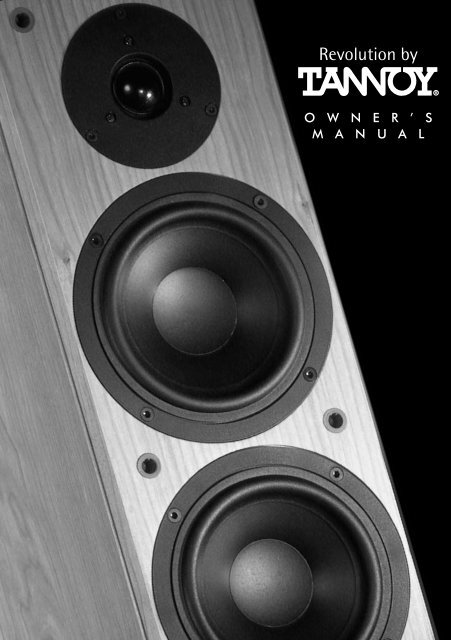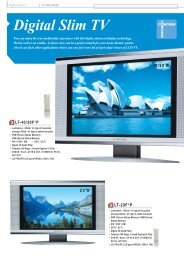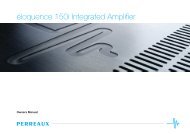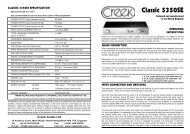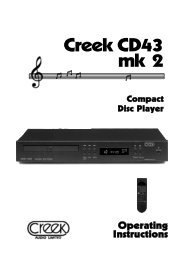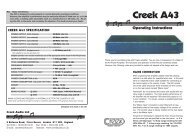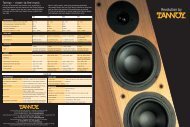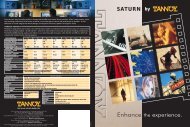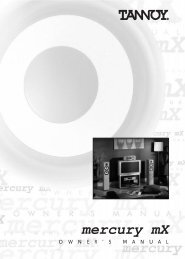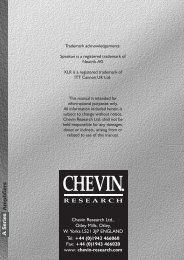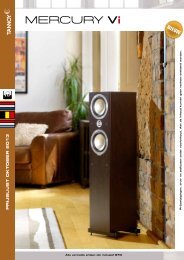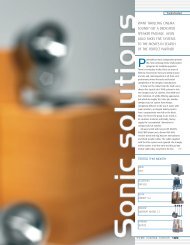Revolution by
Revolution by
Revolution by
Create successful ePaper yourself
Turn your PDF publications into a flip-book with our unique Google optimized e-Paper software.
<strong>Revolution</strong> <strong>by</strong><br />
O W N E R ’ S<br />
M A N U A L
CONTENTS<br />
PAGE<br />
Introduction 2<br />
Amplifier Matching 3<br />
Fine Tuning 4<br />
Bass Tuning 5<br />
Bi-Amping 6<br />
Screening 7<br />
Technical Specifications 8-11<br />
WARRANTY<br />
This equipment has been produced and tested with care and precision. All Tannoy speaker<br />
systems WARRANTY are built to give first class service and carry a 5-year warranty. Active subwoofers<br />
carry a 1-year warranty.<br />
This equipment has been produced and tested with care and precision. All Tannoy<br />
If the speaker equipment systems proves are to built be defective to give first within class this service period and for any carry reason a 5-year other warranty. than accident,<br />
misuse, Active unauthorised subwoofers modification carry a 1-year or warranty. fair wear and tear, Tannoy will repair any such defect<br />
or, at our option, replace it without charge for parts, labour or return carriage. This warranty<br />
is given If the in equipment addition to proves the customer's be defective statutory within rights. this period for any reason other than<br />
accident, misuse, unauthorised modification or fair wear and tear, Tannoy will repair<br />
If you any suspect such defect a problem or, at our with option, your loudspeakers replace it without please charge contact for your parts, local labour Tannoy or return dealer<br />
who carriage. will be able This to warranty advise on is given appropriate in addition action. to the customer's statutory rights.<br />
If you suspect a problem with your loudspeakers please contact your local Tannoy<br />
dealer who will be able to advise on appropriate action.<br />
INTRODUCTION<br />
Thank you for selecting Tannoy loudspeakers; developed in the UK <strong>by</strong> our dedicated team<br />
of design engineers they are the choice of discriminating music lovers the world over.<br />
Musical excellence is designed into our loudspeakers from the start. Careful selection of<br />
the very best components combined with strict quality control procedures in the production<br />
process ensures this level of excellence is maintained.<br />
To gain maximum performance from your loudspeakers, please take time to read this<br />
owner's manual in full before installation. Once you have set up your new loudspeakers<br />
please complete and return the registration document - this does not limit your legal rights.<br />
Loudspeakers are electromechanical devices that 'run-in' through use; performance will<br />
therefore improve after an initial period of 24hrs use. Once they have been further runin<br />
over a longer period, there will be clear enhancement of the stereo imaging, mid-band<br />
quality and bass performance characteristics.<br />
We are confident that you will continue to enjoy your new Tannoy loudspeakers for many<br />
years to come.<br />
2
AMPLIFIER MATCHING<br />
Consult the enclosed product specification sheet as this clearly shows the acceptable power<br />
range for amplifier matching to your speakers. The high peak power handling of Tannoy<br />
loudspeakers permits responsible use with more powerful amplifiers - please read the<br />
Warranty.<br />
As with all loudspeaker systems, the power handling is a function of voice coil thermal<br />
capacity. Care should be taken to avoid overdriving any amplifier, as this will cause output<br />
overload resulting in 'clipping' or distortion within the output signal. This, if done for any<br />
extended period, will cause damage to the speakers.<br />
Generally an amplifier of higher power that is running hard, but free of distortion, will<br />
do less damage to the loudspeaker than a lower power amplifier continually clipping.<br />
Remember also that a high powered amplifier running at less than 90% of output power<br />
generally sounds a great deal better than a lower powered example struggling to achieve<br />
100%. An amplifier with insufficient drive capability will not allow the full performance of<br />
the loudspeakers to be realised.<br />
<strong>Revolution</strong> Range<br />
CABLE CHOICE<br />
Always use the best quality of cable available within your budget. High quality audio<br />
signals passing from the amplifier to the loudspeaker are unusual in their demands on<br />
the cable. Wide dynamic range and frequency bandwidth information has to coexist with<br />
the ability to transmit peak currents of at least 10amps, without incurring any loss or signal<br />
impairment. This explains why the sound quality of the information reproduced <strong>by</strong> the<br />
loudspeakers is so dependant on the physical properties of the cables connecting them<br />
to the amplifier.<br />
Technically, we recommend two-core cable with cross section area not less than 1.5 square<br />
millimetres (1.5mm 2 ) for cable runs of up to 3 metres. For longer lengths you will require<br />
to use cable with a minimum cross sectional area of 2.5 square millimetres (2.5mm 2 ). In<br />
addition always keep the cable runs the same length for each speaker.<br />
Cable construction can affect the sound quality. Be prepared to experiment to find a cable<br />
that suits your ear and audio system. We do not recommend the use of braided (Litz) or<br />
coaxial cables as these have a high capacitance that may affect the stability of certain<br />
amplifiers.<br />
QUICK SET UP<br />
PLEASE REFER TO THE SPECIFICATION AND INSTALLATION DIAGRAM SHEET SUPPLIED<br />
WITH THIS MANUAL<br />
1. Remove the loudspeakers from all packaging.<br />
Fold the carton flaps right back and invert the carton and contents.<br />
Lift the carton clear of the contents.<br />
Remove all the inner packaging from the product.<br />
(See figure 1)<br />
It is strongly recommended that you store all the packaging to allow protected<br />
transportation in future.<br />
2. Stand mounting or bookshelf speakers should be located securely in an appropriate<br />
position. If wall mounting any speakers, we strongly recommend that you use a<br />
bracket which will support the base of the speaker. Use of a bracket that screws directly<br />
onto the back panel of the speaker can cause too much strain to be exerted on the<br />
fixing point and the panel itself. This may cause panel detachment when in use and<br />
could present the risk of injury.<br />
3. Floor-standing models perform best with carpet piercing spikes fitted. These are supplied,<br />
along with lock nuts, and should be fitted into the threaded holes in the base of the<br />
cabinet. Level the speaker and then tighten the lock nuts firmly but without using undue<br />
force. Spike locating cups are provided in the accessory pack and these may be used<br />
to protect sensitive floor surfaces.<br />
3
4. To protect your speakers and amplifier from damage it is important to ensure that the<br />
amplifier is switched OFF prior to connecting or disconnecting any cabling.<br />
* Correct polarity of the cable connections between the amplifier and speakers is<br />
essential. (See figure 2)<br />
* For optimum performance when connecting the system in standard single wire<br />
mode to a speaker terminal panel equipped with full bi-wiring facility, always make<br />
cable connections, with the links fitted, to the HF terminals.<br />
(See figure 2)<br />
* The positive (plus) terminal on the amplifier left channel (marked + or coloured<br />
red) must be connected to the positive terminal on the left speaker. The left speaker<br />
is the one on the left as you look at the stereo pair from your listening position.<br />
* The negative (minus) terminal on the amplifier left channel (marked - or coloured<br />
black) must be connected to the negative terminal on the left speaker.<br />
* Repeat this connection process for the right speaker. Remember that the positive<br />
(+ or red) on the amplifier must be connected to the positive (+ or red) on the<br />
speaker and the negative (- or black) to negative.<br />
* Select a signal source, such as a CD player; switch on the amplifier and slowly turn<br />
up the volume control to check that both loudspeakers are reproducing bass and<br />
treble information.<br />
FINE TUNING<br />
To get best results from your new Tannoy loudspeakers it is worthwhile spending a little<br />
time finding the optimum set-up configuration.<br />
Here are a few tips to help you with this process:<br />
STAND MOUNTING AND BOOKSHELF SPEAKERS<br />
Small speakers should not be placed directly on the floor but can be used on bookshelves<br />
or tables. However, the sound reproduction quality achieved will never be as good when<br />
not ideally positioned. Your dealer can show you a selection of purpose built stands,<br />
designed to realise the full performance potential of your loudspeakers.<br />
Loudspeaker stands should be rigidly built and preferably mass loaded with dry sand. The<br />
optimum listening height will be dictated <strong>by</strong> the seating in your room, usually between<br />
300mm (12") and 600mm (24") high. Stand mounted speakers will produce their best<br />
stereo image and soundstage if you can just see the top face of the cabinet. Check the<br />
'lift' needed to put the speakers in this position before purchasing your stands.<br />
Refer to the paragraph headed Positioning for stand mounted speaker placement advice.<br />
(See figure 3)<br />
FLOOR STANDING LOUDSPEAKERS<br />
For optimum performance from floor-standing loudspeakers, the design team at Tannoy<br />
recommends that the supplied carpet piercing spikes be fitted. A rigid footing for the<br />
speaker, with a secure interface between the cabinet and the floor, brings about an<br />
improvement in clarity, bass 'speed' and definition.<br />
First level the spikes <strong>by</strong> eye then hand tighten the lock nuts. Rock the loudspeaker gently<br />
from side to side so that the spikes find their way through the weave of the carpet and<br />
on to the solid surface below. Once fine adjustments have been made to level the<br />
loudspeaker and ensure stability, tighten the lock nuts firmly but without using undue force.<br />
Refer to the paragraph headed Positioning for floor standing speaker placement advice.<br />
(See figure 3)<br />
4
BASS TUNING<br />
Floor-standing loudspeakers with a sealed mass-loading cavity in the base of the cabinet<br />
can be loaded with either dry sand or lead shot. This cavity is accessed <strong>by</strong> removing the<br />
rubber bung from the small hole in the rear of the enclosure; the loading material can<br />
then be carefully inserted. The increase in mass and improved stability will further enhance<br />
the bass definition and overall dynamic performance.<br />
Many Tannoy loudspeakers are also provided with a foam port damper bung inside the<br />
port tube located on the front or rear panel of the cabinet. The speakers have been<br />
designed for use in rooms with average to good acoustics without these dampers fitted,<br />
so please take them out before use.<br />
In smaller rooms, where loudspeaker positioning is forced closer to rear or side walls, the<br />
port damper can be inserted into the reflex port. This will reduce the bass energy but<br />
'speed-up' the sound presentation. There is no absolute right or wrong here, therefore<br />
much will depend on your own musical preferences.<br />
<strong>Revolution</strong> Range<br />
POSITIONING<br />
Begin <strong>by</strong> angling the speakers towards your chosen listening position, usually this is on<br />
the centre line of the room, so that when seated you can just see the inner side panel of<br />
each speaker.<br />
The front of the loudspeaker should not be obstructed in any way.<br />
The loudspeakers should be located between 1.5 to 4.5 metres (5ft to 15ft) apart - with<br />
the listening position set slightly further away than the speakers are apart.<br />
Avoid positioning the loudspeakers in corners of the room, as this will have a negative<br />
effect on performance; maintain a distance of at least 0.5 metres (20 inches) from the<br />
rear wall, and 1 metre (39 inches) from the side. (See figure 3)<br />
BI-WIRING<br />
Where the facility to bi-wire your loudspeakers is provided we would strongly recommend<br />
that you install your system using this wiring option. With this method you will require<br />
separate cable feeds from your amplifier to the HF and LF units of each loudspeaker.<br />
Generally this will result in a significant improvement in resolution, transparency, stereo<br />
focus and instrument separation.<br />
Use a high quality bi-wire cable to connect the speakers to the amplifier. It is recommended<br />
that the same cable length and type be used for both bass and treble.<br />
It is essential that the coupling links between the loudspeaker terminals be removed.<br />
Avoid potential damage to your amplifier - ensure that all connections are secure and the<br />
polarity is correct in all wiring.<br />
(See figure 4)<br />
* Be sure that the amplifier is switched OFF and then prepare the two sets of cabling for<br />
each 'side' of the system separately. Measure and cut four lengths of cable, two per<br />
speaker.Label two of the cable lengths Left LF and Left HF (low frequency and high<br />
frequency) then repeat this process for the right pair.<br />
* Undo the speaker terminals and remove the link bar - retain these in a safe place for<br />
future use.<br />
* If your amplifier is not equipped with separate output terminals for bass and treble<br />
information then, at the amplifier end of the cables, twist the Left LF+ (positive) and the<br />
Left HF+ (positive) together. Connect these to the amplifier Left channel positive terminal<br />
marked + (plus) or coloured red.<br />
Twist the Left LF- (negative) and the HF- (negative) cables together and connect them to<br />
the amplifier Left channel negative terminal marked - (minus) or coloured black.<br />
5
At the loudspeaker end connect the cables labelled Left LF+ and Left LF- to the left hand<br />
loudspeaker LF terminals, ensuring that you note the polarity markings on the cable<br />
sheathing.<br />
Then proceed to connect the Left HF+ and Left HF- to the HF terminals on the same<br />
loudspeaker.<br />
* Repeat this process to connect the right hand loudspeaker to the amplifier right channel<br />
output, once again ensuring that polarity is correct throughout.<br />
* Switch the amplifier on with the volume control set at its lowest setting. Select a favourite<br />
source and slowly turn up the volume to a low level. Check that bass and treble information<br />
is being reproduced from both speakers- if not, switch off the amplifier and recheck the<br />
connections.<br />
BI-AMPING<br />
Bi-Amping extends the principle of bi-wiring one stage further. In this connection option<br />
separate power amplifiers are used for bass and treble signals in each loudspeaker. Four<br />
mono (or two stereo) amplifiers of the same type are required for a stereo pair of<br />
loudspeakers. Ensure that the links between the loudspeaker terminals are removed and<br />
that correct polarity is maintained throughout.<br />
If two stereo amplifiers are used, it is recommended that one amplifier supply bass<br />
information to left and right loudspeakers and the other, the treble information.<br />
(See figure 6)<br />
GRILLES<br />
Special acoustically transparent material is used on the grilles. However, for ultimate fidelity<br />
the enthusiast will appreciate the slight improvement in clarity and detail that is achieved<br />
<strong>by</strong> removing the grilles during listening.<br />
CARE OF THE CABINET<br />
Vinyl finished enclosures normally require no more than a wipe with a dry polishing cloth.<br />
Fingerprints or other more stubborn marks need only a gentle wipe with a slightly damp<br />
cloth.<br />
Real wood veneer cabinets should only be cleaned with a dry cloth or with a light application<br />
of quality non-silicon furniture polish. It should be remembered that as a natural substance<br />
all wood products will change colour when exposed to the UV content of ambient light.<br />
Light veneer will darken appreciably to a rich natural patina; it is advisable to remove the<br />
front grille for the first few weeks of use to ensure an even colouration overall.<br />
HOME CINEMA 5.1<br />
Unlike other forms of encoded surround audio, 5.1 offers full bandwidth capability for<br />
the surround and centre channels, with the ability to treat the subwoofer as a single discreet<br />
channel for special effects playback or, for music applications, as a dedicated low frequency<br />
instrument channel. This places new demands on the surround and centre channel<br />
loudspeakers in both the mixing environment and the playback environment.<br />
The 5.1 format allows the mix engineer in the recording studio to assign audio information<br />
to one or more discreet channels of playback; providing very vivid and exacting localisation<br />
for the apparent sound sources in the listening environment. To reliably recreate that<br />
accurate localisation during playback, the selection and location of loudspeakers becomes<br />
the single most critical issue next to the talent of the mix engineer in the studio.<br />
THE SYSTEM<br />
6<br />
A fully operational 5.1 system consists of two main front loudspeakers, two rear effects<br />
speakers at the rear (usually wall mounted) and a centre channel. The subwoofer provides<br />
the .1 part of the system.<br />
(See figure 5)
SCREENING<br />
Loudspeaker drive units contain large magnets. These are capable of generating a<br />
substantial magnetic field extending a considerable distance beyond the sidewalls of the<br />
speaker enclosure. This field will cause picture distortion if the speakers are placed too<br />
close to the TV. With many home cinema loudspeaker products steps are taken to shield<br />
the drivers with the installation of a heavy steel cup around the magnet assembly. In most<br />
cases this will prevent any problems, but it should be borne in mind that some TV designs<br />
are more sensitive to magnetic field than others.<br />
It is therefore recommended that the front (left and right) speakers are positioned at least<br />
0.6 metres (20 inches) to each side of the television screen.<br />
Centre channel speakers, which are designed for mounting directly on top of the TV, often<br />
have an additional steel plate inserted into the bottom of the enclosure to avoid any<br />
interaction with the screen.<br />
<strong>Revolution</strong> Range<br />
FRONT SPEAKERS<br />
The main speaker pair provides much of the delivery of the front soundstage; they should<br />
therefore be large enough to handle the power output and dynamics required. Stand<br />
mounted speakers can be used for this purpose but the power handling and extra bass<br />
extension achievable from floor standing models will add greatly to the overall assurance<br />
of the performance. The speakers should be positioned either side of the TV or projection<br />
screen placed in line with the screen surface.<br />
CENTRE CHANNEL SPEAKERS<br />
As the main effects speaker for the front soundstage, the critical factor in its performance<br />
is placement. In all cases the centre channel speaker should be placed as near to the TV<br />
screen as possible; effective shielding will allow placement on top of the TV itself. If the<br />
shape of the top of the TV casing will not allow a stable placement it can be shelf mounted<br />
just above. The viewing position when seated determines the ideal mounting height, but<br />
in all cases this should be as close as possible to ear height<br />
As with the main speakers the front baffle panel should be as near as possible in line with<br />
the screen surface.<br />
REAR EFFECTS SPEAKERS<br />
The integrity of the special effects soundstage created <strong>by</strong> the source material will be<br />
compromised if the speakers are installed on the sidewalls, for that reason they should<br />
always be placed behind the main viewing position.<br />
The placement of floor standing speakers at the rear should mirror as near as possible<br />
the location of the front pair and 0.5 metres (20 inches) from the rear wall. Wall-mounted<br />
loudspeakers should be shelf or bracket mounted 1.5 to 4.5 metres (5ft to 15ft) apart with<br />
a height mounting height range of 1.5 to 2 metres (5ft to 7ft).<br />
SUBWOOFER<br />
As the subwoofer only produces low frequency, therefore monaural information, it is difficult<br />
to detect its location <strong>by</strong> ear. It could as a result be situated anywhere in the room, but<br />
optimum performance will be gained <strong>by</strong> locating the subwoofer between the main stereo<br />
pair of speakers. Bass output will increase when placed next to a wall or in a corner so<br />
use the subwoofer volume control to balance the output with the rest of the system.<br />
For best results on a carpeted floor, screw the spikes provided into the threaded inserts<br />
underneath the cabinet, and adjust until level then tighten the lock nuts firmly but without<br />
undue force. On a polished wooden floor use the discs, included in the accessory pack,<br />
under the spike points to prevent damage to the surface.<br />
7
TECHNICAL SPECIFICATIONS<br />
PERFORMANCE<br />
Recommended amp. power Watts RMS<br />
Continuous power handling Watts RMS<br />
Sensitivity (2.8 Volts @ 1 m)<br />
Nominal Impedance (Ohms)<br />
Frequency response +/– 3dB<br />
R1<br />
10-70<br />
50<br />
87dB<br />
8<br />
55Hz-20kHz<br />
R2<br />
20-150<br />
90<br />
88dB<br />
6<br />
44Hz-20kHz<br />
R3<br />
20-170<br />
105<br />
89dB<br />
6<br />
39Hz-20kHz<br />
RC<br />
20-150<br />
90<br />
90dB<br />
6<br />
50Hz-20kHz<br />
DRIVE UNIT<br />
High Frequency<br />
Low frequency<br />
CROSSOVER<br />
Frequency<br />
Type<br />
25 (1”) soft dome<br />
130 (5”) resin<br />
impregnated long throw<br />
cone<br />
2.5 kHz<br />
2nd order high frequency<br />
2nd order low frequency<br />
25 (1”) soft dome<br />
130 (5”) resin<br />
impregnated long throw<br />
cone<br />
2.5 kHz<br />
2nd order high frequency<br />
2nd order low frequency<br />
25 (1”) soft dome<br />
2 x 165 (6.5”) resin<br />
impregnated long throw<br />
cone<br />
2.3 kHz, 300 Hz<br />
3rd order high frequency<br />
2x2nd order low frequency<br />
25 (1”) soft dome,<br />
fully shielded<br />
2 x 130 (5”) resin<br />
impregnated long throw<br />
cone<br />
2.5 kHz<br />
3rd order high pass<br />
2nd order low pass<br />
CABINET<br />
Enclosure type<br />
Shielding<br />
Dimensions H x W x D (mm)<br />
Dimensions H x W x D (inches)<br />
Weight kgs (lbs)<br />
Finish options<br />
Ported reflex<br />
300 x 170 x 210<br />
11.8 x 6.7 x 8.3<br />
4.75 (10.5)<br />
Cherry veneer<br />
Ported reflex<br />
920 x 170 x 235<br />
36.2 x 6.7 x 9.3<br />
13 (28.7)<br />
Cherry veneer or Black Ash<br />
Ported reflex<br />
1020 x 184 x 271.5<br />
40.2 x 7.2 x 10.7<br />
18 (39.7)<br />
Cherry veneer or Black Ash<br />
Twin Ported reflex<br />
Two heavy gauge steel<br />
plates, top and bottom<br />
185 x 500 x 245<br />
7.3 x 19.7 x 9.6<br />
17 (37.5)<br />
Cherry veneer or Black Ash<br />
PERFORMANCE<br />
Output Power - RMS (Watts Peak)<br />
Low frequency response<br />
Inputs<br />
Input sensitivity<br />
Input filter<br />
Auto mute<br />
Auto power on threshold<br />
DRIVE UNIT<br />
Driver type<br />
Driver size mm (inches)<br />
Voice coil resistance - Ohms<br />
ENCLOSURE<br />
Type<br />
Volume<br />
Size (h x w x d) mm (inches)<br />
Weight kg (lbs)<br />
Mains Voltage<br />
Mains Fuse<br />
Finish<br />
R-SUB15<br />
200 (400 ) - subject to thermal limitations<br />
-6dB at 25Hz, in room typical response<br />
Line or loudspeaker level, stereo or mono<br />
175mV (line), 1.25V (loudspeaker level), for full output, one input driven<br />
2nd order low pass, variable between 55Hz - 100Hz, -6dB. 1st order high pass for main speaker output and line level output, -6dB @ 75Hz.<br />
After approximately 15 mins., in absence of input signal<br />
2.75V at 50Hz (one line level input driven). 50mV at 50Hz (one speaker input driven).<br />
Long throw bass unit, cast chassis, twin voice coils<br />
380 (15)<br />
2 x 6<br />
Twin ducted port<br />
95 litre<br />
475 x 520 x 505 (18.7 x 20.5 x 19.9) Inc. grille<br />
34 (75)<br />
230V nominal (220 - 240V), 50 - 60HZ or 115V nominal (100 - 120V), 50 - 60HZ<br />
T2A (230V) or T4A (115V)<br />
Cherry enclosure with a black grille<br />
<strong>Revolution</strong> Range Range
SET-UP DIAGRAMS<br />
FIG. 1<br />
FIG. 2<br />
TO RIGHT<br />
SPEAKER<br />
+ - + -<br />
L R<br />
POWER AMPLIFIER<br />
LF- HF- HF+ LF+<br />
LINKS IN PLACE<br />
<strong>Revolution</strong> Range Range
SET-UP DIAGRAMS<br />
FIG. 3<br />
0.5 METRES OR MORE<br />
1.5 TO 4.5 METRES<br />
1 METRE<br />
OR MORE<br />
FIG. 4<br />
TO RIGHT<br />
SPEAKER<br />
+ - + -<br />
L R<br />
POWER AMPLIFIER<br />
LF- HF- HF+ LF+<br />
LINKS REMOVED<br />
<strong>Revolution</strong> Range Range
SET-UP DIAGRAMS<br />
FIG. 5<br />
0.5 METRE<br />
OR MORE<br />
1.0 METRE<br />
OR MORE<br />
SUB<br />
1.5 TO 4.5 METRES<br />
HEIGHT FROM FLOOR<br />
1.5-2.0 METRES<br />
FIG. 6<br />
LF-<br />
LF+<br />
+ -<br />
L<br />
+ R -<br />
HIGH FREQUENCY<br />
POWER AMPLIFIER<br />
HF-<br />
HF+<br />
LINKS REMOVED<br />
LOW FREQUENCY<br />
POWER AMPLIFIER<br />
+ L - + R<br />
-<br />
<strong>Revolution</strong> Range Range
Tannoy Limited, Home Audio Division, Coatbridge, Scotland, ML5 4TF.<br />
Tel: +44 (0) 1236 420199 Fax: +44 (0) 1236 428230<br />
e-mail: sales@tannoy.com Website: www.tannoy.com<br />
Tannoy/TGI North America Inc., Suite 1, 335 Gage Avenue,<br />
Kichener, Ontario, Canada N2M 5E1<br />
Tel: (519) 745-1158 Fax: (519) 745-2364<br />
e-mail: inquiries@tgina.com Website: www.tannoy.com<br />
Tannoy Nederland b.v., Anthonetta Kuijlstraat 19, 3066 GS Rotterdam.<br />
Tel: (010) 286 0555 Fax: (010) 286 0431<br />
e-mail: info@tannoy.nl Website: www.tannoy.nl<br />
6483 0696


